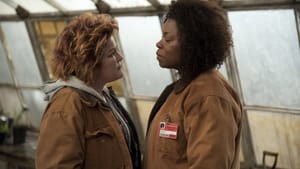Stay in the Loop
BSR publishes on a weekly schedule, with an email newsletter every Wednesday and Thursday morning. There’s no paywall, and subscribing is always free.
Truth and consequences
'Orange Is the New Black,' Season Two

There's a long tradition of movies about women in prison, from the pre-Code '30s (Barbara Stanwyck in Ladies They Talk About) through the noir '50s (Eleanor Parker and Agnes Moorehead in Caged) to the soft-core porn '70s (a post-Exorcist Linda Blair in Chained Heat, blaxploitation icon Pam Grier in The Big Bird Cage, and Jonathan Demme's directorial debut, the Roger Corman-produced Caged Heat). Women taking showers, lesbian sex — who cares if the plotting was cheesy and the acting was execrable?
Netflix's Orange Is the New Black is the heir of that tradition in that there are plenty of shower scenes and a whole lot of lesbian sex, some of it extremely graphic. It also takes a sharp turn away from that tradition in that the characters are well thought-out and complex and that they're in prison for reasons that reflect the social realities of jurisprudence in the 21st century — lots and lots of drug charges, no misplaced innocents.
The show is based, extremely loosely, on the memoir of the same title by Piper Kerman. Soon after college, she was traveling the world with her heroin-trafficking girlfriend Alex, finally moving some money for her when Alex was short-staffed. Ten years later, that youthful indiscretion had been completely buried, and Piper was engaged to a man, Larry, when her past caught up with her. On the advice of her lawyer, she chose to plead guilty and was sentenced to 15 months in a minimum-security prison.
All of that is just show creator Jenji Kohan's starting point: She changes the main character's surname to Chapman, fictionalizes the prison (Litchfield, in the show), and makes significant changes to the story in the interest of drama.
Piper Chapman (Taylor Schilling) comes across immediately as a particularly annoying exemplar of entitled WASPiness, utterly lacking in any kind of self-, or social, awareness. Naturally, this causes her to put her foot wrong the minute she gets to Litchfield: She disparages the food in the presence of Red (Kate Mulgrew), the Russian inmate who runs the kitchen.
The time before doing time
The first season follows Piper's acclimation to prison life — the tedium; the arbitrary rules, arbitrarily enforced; the petty cruelties of the inmates, who treat one another with the lack of empathy typical of a middle school cafeteria. We learn about Piper and her fellow inmates through flashbacks to their pre-prison lives. Sometimes these flashbacks indicate clearly the crimes the women committed, and sometimes they merely show the situations they were in — the specific crime being in some ways quite unimportant.
We thus get to know a variety of women — the transgender Sophia (Laverne Cox), Piper's scarily self-contained bunkmate Miss Claudette (Michelle Hurst), the meth addict turned pro-life poster child Pennsatucky (Taryn Manning). We also see some of the backstory of Piper's relationship with Alex (Laura Prepon), who, it turns out, is also serving her time at Litchfield.
There's a fair amount of story in Season One: the Piper-Larry-Alex love triangle and Larry's (Jason Biggs) use of the stories Piper tells him as material to further his writing ambitions. The main story arc is Piper's often rocky adjustment to prison life. She tries to get along, but she seems congenitally unable to think before she speaks, creating conflicts both with other prisoners and with staff. Even as she learns her lesson — kind of — her previous indiscretions continue to affect her: When Larry wangles a spot on a This American Life-type radio show, we watch the inmates' faces as they hear what Piper had told Larry about them.
The underlying theme of all of the strands of these stories is the choices that people make, sometimes consciously and sometimes unconsciously. Those choices, Kohan seems to suggest, tend to be consistent through our lives, coming out of the stories we tell ourselves about ourselves.
Racial politics
This theme of choices comes into even sharper focus in Season Two, released in its entirety on June 6. In this season, the racial dynamics of prison life come to the fore. Red has lost her kitchen job, and we watch her efforts to maintain her alpha position amongst the whites and to find a new power base. Her main nemesis isn't Latina Gloria (Selenis Leyva), who is given the head cook job, but Vee (Lorraine Toussaint), who's returning to Litchfield for a second stint and is eager to unify the blacks under her leadership.
 Kohan shows the creation and maintenance of these three racial power blocs, not just in terms of the machinations of the leaders but in the ways potential followers respond to their blandishments. Taystee (Danielle Brooks) and Poussey (Samira Wiley), for instance — pals treated as a cross between a minstrel-show line and a Greek chorus in Season One — come into their own in Season Two. We find out much more about their backstories, which illuminate their very different reactions to Vee's arrival and the choices they subsequently make.
Kohan shows the creation and maintenance of these three racial power blocs, not just in terms of the machinations of the leaders but in the ways potential followers respond to their blandishments. Taystee (Danielle Brooks) and Poussey (Samira Wiley), for instance — pals treated as a cross between a minstrel-show line and a Greek chorus in Season One — come into their own in Season Two. We find out much more about their backstories, which illuminate their very different reactions to Vee's arrival and the choices they subsequently make.
Not everyone is drawn directly into these power struggles, but each character has her own decisions to make.  The women who enter prison with the intention of behaving with Zen equanimity, like Yoga Jones (Constance Shulman), or Christian forbearance, like the nun (Beth Fowler) imprisoned because of her anti-nuke protests, struggle with their choices. Both women are confronted with situations in which they must decide to merely maintain their values, as when Yoga Jones is taunted by a fellow prisoner in Season One, or to act on them, as when Sister Ingalls is challenged to stand up for what's right by Season Two's annoying naïf, Soso (Kimiko Glenn).
The women who enter prison with the intention of behaving with Zen equanimity, like Yoga Jones (Constance Shulman), or Christian forbearance, like the nun (Beth Fowler) imprisoned because of her anti-nuke protests, struggle with their choices. Both women are confronted with situations in which they must decide to merely maintain their values, as when Yoga Jones is taunted by a fellow prisoner in Season One, or to act on them, as when Sister Ingalls is challenged to stand up for what's right by Season Two's annoying naïf, Soso (Kimiko Glenn).
The prisoners, of course, are not the only denizens of Litchfield, and Season Two's themes of choice, power, and morality are acted out among the staff as well. The disclosure at the end of Season One that assistant warden Natalie "Fig" Figueroa (Alysia Reiner) is on the take becomes a major plotline in Season Two, with Fig's underling, Joe Caputo (Nick Sandow), joining in the effort to bring her down. Caputo, though genuinely concerned about the prisoners, is no single-shade character himself: We first meet him early in Season One when he allows Piper to use his phone on her first day in Litchfield, then masturbates after she leaves his office.
Virtually all of these characters are complex mixtures of a sort we don't often seen on TV — or in most mass media, for that matter — and we definitely don't see with a primarily female set of characters. (I must assume that Alison Bechdel is a huge fan of the show.) No one is simply "good" or "bad" — each character shows a very human mixture of selfishness and understanding.
For Paula Berman's consideration of Piper and other female antiheroes on television, click here.
For Alaina Mabaso's review of Orange Is the New Black, click here.
Above right: Poussey and Taystee (photo by Jessica Miglio - © 2014 - Netflix)
Above left: Yoga Jones and Sister Ingalls (photo © 2013 - Netflix)
What, When, Where
Orange Is the New Black, Season Two. Created by Jenji Kohan, based on the novel by Piper Kerman. Available for streaming on Netflix.
Sign up for our newsletter
All of the week's new articles, all in one place. Sign up for the free weekly BSR newsletters, and don't miss a conversation.

 Judy Weightman
Judy Weightman